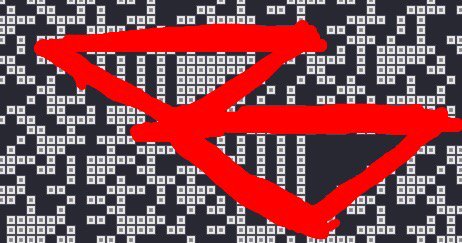If you write the Fibonacci sequence using binary representation for each number, a picture like this emerges:

Every column of small rectangles is a Fib(N) value, written vertically in binary, with lowest bit at the bottom. Looking at the picture, it is quite clear that the dependency between N and the number of bits to represent Fib(N) is linear. I’m curious though, how to mathematically prove that… (I’m sure @LoopSpace can do that in like 5 seconds, but still… ![]() )
)
Code is here, if anyone needs it:
--# Main
-- Fibobits
displayMode(OVERLAY)
displayMode(FULLSCREEN)
-- Use this function to perform your initial setup
function setup()
A,B = 0,WIDTH/5
bitSize = 5
i = 0
nums = {{ 1 }, { 1 }}
for i=3,B do
nums[i] = add(nums[i-2], nums[i-1])
end
print("prepped: " .. B)
end
function add(a, b)
local c = {}
local n = math.max(#a,#b)
local carry = 0
for i=1,n do
c[i] = (a[i] or 0) + (b[i] or 0) + carry
if c[i] > 1 then
carry = 1
c[i] = c[i] - 2
else
carry = 0
end
end
if carry > 0 then
c[n+1] = 1
end
return c
end
-- This function gets called once every frame
function draw()
-- This sets a dark background color
background(40, 40, 50)
-- This sets the line thickness
strokeWidth(2)
-- Do your drawing here
if fibImg then
translate(WIDTH/2, HEIGHT/2)
sprite(fibImg)
else
pushStyle()
text("Preparing image ...", WIDTH/2, HEIGHT/2)
stroke(85, 83, 140, 255)
noFill()
rect(WIDTH/2 - 150, HEIGHT/2 - 50, 300, 20)
fill(95, 92, 111, 255)
noStroke()
rect(WIDTH/2 - 150, HEIGHT/2 - 50, 300*i/(B-A), 20)
popStyle()
co = co or coroutine.create(function()
local img = image(WIDTH, HEIGHT)
local count = 0
local s = bitSize
setContext(img)
i = 1
while i<=B-A do
local b = nums[i+A]
for j=1,#b do
count = count + 1
if b[j] == 1 then
rect(i*s,j*s,s,s)
end
if count % 1000 == 0 then
setContext()
coroutine.yield()
setContext(img)
end
end
i = i + 1
end
fibImg = img
setContext()
end)
coroutine.resume(co)
end
end
